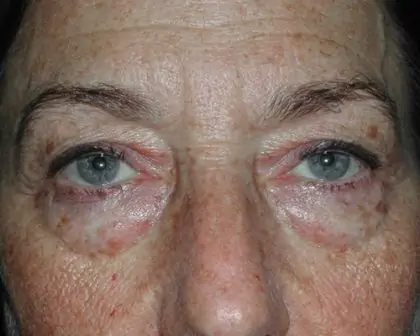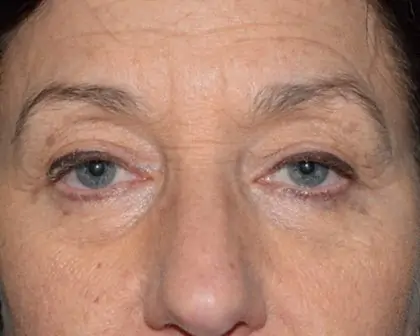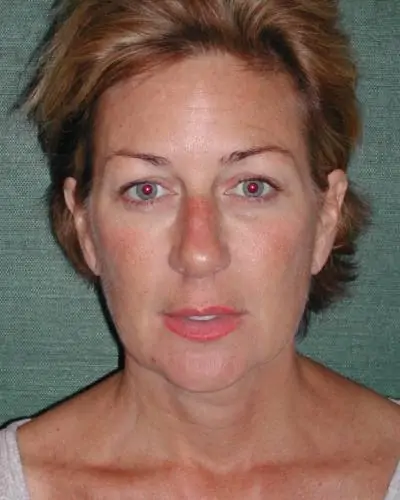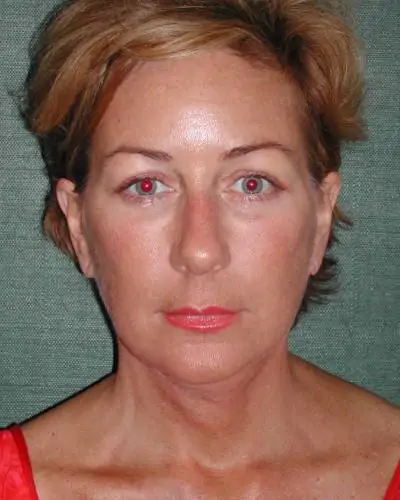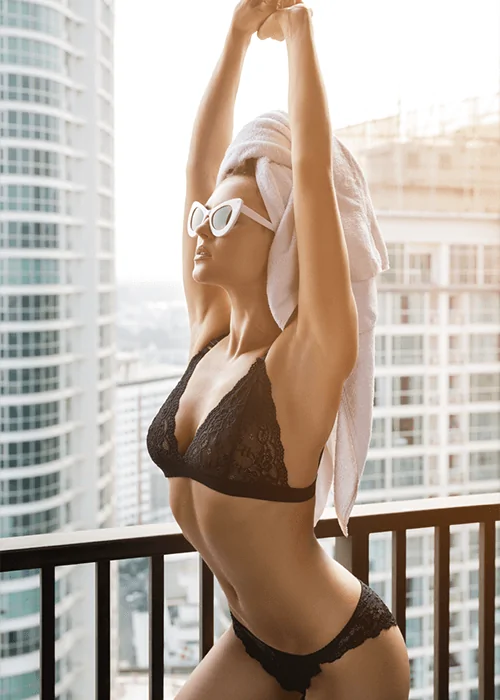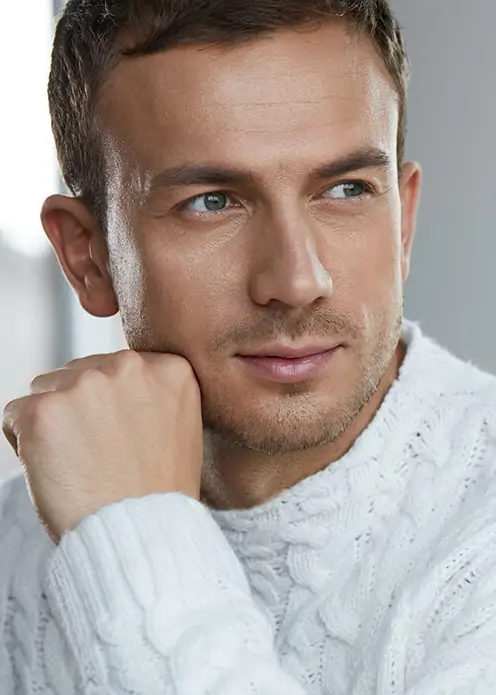The eyes can make us look more tired than we are or may convey sadness or anger when we are feeling anything but. New York Plastic Surgeon Dr. Steven Wallach recreates a natural-looking, youthful eye by treating the necessary fat and skin from the upper and lower lids to give his Manhattan patients the bright, youthful eyes they desire. Dr. Wallach is careful to conserve soft tissue in and around the eye to prevent the hollowed-eye look, another sign of aging. If possible, Dr. Wallach will treat the lower eyelids using an incision on the inside of the lid to avoid scarring. There are various methods for treating the eyes, and we will describe Dr. Wallach’s methods below. The surgical procedure usually takes one to two hours, with a recuperation period of about seven to ten days so you can show your beautiful eyes off to the world.
Dr. Wallach believes that true confidence comes from a feeling of self-assuredness from one’s inner self. However, he also believes it is heavily impacted by a lack of confidence with one’s outside appearance. Plastic surgery can help improve confidence in this way. To schedule your consultation and boost your confidence with Dr. Wallach, call (212) 861-6400 or fill out this form to get started.
Contents
show- Before and After Photos
- Periorbital Rejuvenation
- Lower Lid-Cheek Problems
- Ideal Candidates for Blepharoplasty
- Personal Consultation
- Preparation
- The Blepharoplasty Procedure
- Surgical Rejuvenation Techniques
- Recovery and Results
- Ancillary Procedures
- Non-Invasive Procedures
- What is the Cost of Eyelid Surgery in Manhattan?
- References
- FAQs
Periorbital Rejuvenation
UPPER EYELID REJUVENATION
The goal of upper eyelid rejuvenation is to restore the youthful appearance of the periorbita without hollowing out the eye. A taut upper eyelid is often a sign of youth, and many of our patients desire attention in this area.
The upper eyelid area focuses on the inter-relationship between the brow and the upper lid. If the brow is too low, a drooping upper eyelid can be mistaken as the cause of excess upper eyelid skin when in reality it is often caused by the descent of the brow. Sometimes an upper eyelid procedure is recommended with or without a brow lift. Since the upper eyelid also has two fat pockets, these may need to be addressed.
LOWER EYELID REJUVENATION
Proper evaluation and treatment of the skin, muscles, and fat of the lower eyelid will improve the appearance of an aging eye since the lower eyelid contributes to the overall aesthetic of the periorbital region.
Some of the characteristic changes in the lower lids with age include
- Loose skin
- Herniated orbital fat
- Accentuation of the lid-cheek junction
- Accentuation of the tear trough region
- Weakness of the lower lid
Lower eyelid laxity, when not addressed, can contribute to the scleral show (too much white of the eye), or worse, ectropion, which is the pulling down of the lower lid. When the lower eyelid is weak, a supporting procedure is necessary; this can be done by performing a canthopexy or even a canthoplasty.
WHAT IS A CANTHOPEXY?
A canthopexy is a procedure to support the lower eyelid in patients with poor lower lid tone; this is often detected by a lid distraction test or while performing a lid retraction (snap back) test. Patients at risk for poor lower lid tone and the sequelae of ectropion or scleral show are those with a poor snap back test, distraction test, and a negative vector or very flat cheeks. [1]
WHAT IS A CANTHOPLASTY?
A canthoplasty is similar to a canthopexy except that it is used to shorten the lower lid because of laxity and stretching of the lateral canthal tendon.
If you would like more information about blepharoplasty, surgeon Dr. Wallach, and his success with New York City Eyelid procedures, we hope that you will not hesitate to contact our Manhattan offices at (212) 861-6400 or by using our contact form to request additional details.
Lower Lid-Cheek Problems
MALAR BAGS
Malar bags or malar edema are areas of swelling along the lateral lid-cheek junction. They are similar to the condition causing swollen feet and increased activity and salt intake may worsen them.
Sometimes surgery around the eye may make them more noticeable. As patients age, they can commonly look worse because the soft tissue in this area descends, and the overlying skin thins. There is no definitively one good treatment for this problem, and it may not improve, but sometimes face lifting in this area can camouflage it.
FESTOONS
Festoons are out-pouching of the muscle in the lid-cheek junction, which causes the muscle and skin to hang like drapes. A “squinch” test is performed to see if the festoon is made of more muscle or skin.
Often the best treatment for this during blepharoplasty is to elevate a skin flap and either overlap the redundant muscle or take a crescent of muscle out directly over the festoon. [2]
Ideal Candidates for Blepharoplasty
A good candidate for blepharoplasty is typically an adult who is in good overall health and has realistic expectations for the procedure. The procedure is most often performed on men and women who have excess skin or fat around the eyelids causing a sagging or tired appearance, or those who have problems with vision due to excess skin on the upper eyelids.
In general, blepharoplasty is not recommended for individuals who:
- Are pregnant or nursing
- Have uncontrolled thyroid issues or other medical conditions that could affect healing
- Have dry eye or other ocular surface diseases that are not adequately controlled
PATIENTS WITH ENTROPION OR ECTROPION
Entropion occurs when the lower lid margins actually curl inward and the lashes irritate the eye. Treatment often requires excision of skin and muscle along the lid margin to help evert the lash line.
Ectropion is more common in patients with lower lid laxity. Patients who have scleral show (more white of the eye showing) or a negative vector in which the cheekbone is slightly behind the bony orbital rim have a higher risk of ectropion. If the patient shows poor lower lid tone during a distraction test or snap back test, they are more prone to develop an ectropion.
Personal Consultation
During a consultation for blepharoplasty, you will meet with Dr. Wallach to discuss your goals for the procedure. He will examine your eyelids and may also ask you about your medical history, including any previous surgeries or medical conditions you have. During the physical examination, the eyelids are tested for laxity. A “snap-back” test can be performed to see how well the eyelid will return to its normal position.
Dr. Wallach will explain the procedure in detail, including the potential risks and benefits, and answer any questions you may have. If you want to see before and after photos of other patients who have undergone blepharoplasty, Dr. Wallach can provide these for you.
You must be open and honest with Dr. Wallach during the consultation, as this will help him determine if you are a good candidate for blepharoplasty and develop a treatment plan tailored to your needs and goals. You should also feel comfortable asking him any questions you may have and discussing any concerns you have about the procedure
Preparation
In preparation for the surgery, Dr. Wallach may ask you to:
- Stop taking certain medications, such as blood thinners that could interfere with the procedure
- Avoid alcohol, tobacco, and certain supplements for a period of time before and after surgery
- Arrange for someone to drive you home after the surgery
Following Dr. Wallach’s instructions carefully is important to ensure a successful procedure and recovery.
The Blepharoplasty Procedure
Eyelid surgery is performed under sedation or general anestheisa and takes around one to two hours to complete. A traditional blepharoplasty can be performed for both the upper and lower eyelids. A crescent of skin and muscle is removed from the upper eyelid usually six to eight millimeters above the lash line and a variable amount of fat is removed from the central and medial fat pockets as necessary. [3]
For the lower lid, an incision is made just inferior to the lash line elevating a skin-muscle flap. A transconjunctival approach can also be used along the internal conjunctival tissue to avoid an incision along the outer lower eyelid margin. This avoids an incision along the lower lid in some cases. This may or may not be combined with a small “skin pinch” along the lower lid margin if there is evidence of excess skin. Variable amounts of fat from the three fat pockets are removed or draped over the orbital rim. If a lower lid skin–muscle flap is performed, then this flap can be trimmed to remove the redundant tissue.
Sutures are usually removed within a few days to a week.
MORE ABOUT UPPER LID BLEPHAROPLASTY
Traditionally, a natural-looking upper lid blepharoplasty entails:
- Removing a crescent-shaped amount of skin and muscle at the level of the upper eyelid crease at or just above the tarsus.
- Fat removal from both the central and medial compartments.
- Dr. Wallach believes that the youthful eye has a full look so he will only take a small strip of excess skin at the crease level, usually leaving the muscle intact and the underlying central fat.
- If it is herniated or protruding, the medial fat will be removed conservatively.
The incision is closed, and the sutures are removed within the week.
MORE ABOUT LOWER LID BLEPHAROPLASTY
There are several ways to perform a lower lid blepharoplasty, and Dr. Wallach’s choice of procedure depends upon the specific anatomical issues of the patient.
- Usually, a skin muscle flap is elevated just below the eyelash margin.
- Dr. Wallach also performs a transconjunctival procedure – an incision along the conjunctiva inside the eyelid to expose the fatty compartments.
- He removes fat conservatively or drapes the fat along the lower lid-cheek crease. Often, he will free the crease of the lower lid-cheek junction.
- If there is excess skin when using the transconjunctival approach, he will “pinch” the excess skin and remove it conservatively at the level just below the lash line.
- He will perform a canthopexy if the patient has a poor lower lid tone.
If lower lid skin is removed, the sutures are usually removed within several days to a week.
HOW IS A CANTHOPEXY PERFORMED?
A canthopexy is performed by placing a suture through the lateral canthal ligament and suspending it to the connective tissue along the inner lateral orbital rim. [4] Dr. Wallach likens this to suspenders on a pair of pants that holds the lower lid in place during the healing process. Early post-op, the patient’s eye may appear slightly almond-shaped, but as the area heals the shape usually returns to normal.
How is a Canthoplasty Performed?
The lateral canthal tendon is shortened in a similar fashion to a canthopexy, and it is suspended to the inner lateral orbital rim (the outer corner of the eye); this is performed to support the lower lid to minimize the risk of ectropion or scleral show. One issue with this technique is that it will change the eye shape a bit.
WHAT IS A PINCH BLEPHAROPLASTY?
A pinch blepharoplasty is performed to remove excess skin in the lower lid. Dr. Wallach “pinches” the skin along the lower lid margin just below the lash line. The excess skin that is in the “pinch” is then trimmed and the resulting incision is closed; this is performed without violating the muscle layer.
DOUBLE EYELID PROCEDURE
The double eyelid procedure is often done for patients of Asian descent. The goal of this procedure is to create an eyelid crease that was not naturally present. There are numerous ways to do this, including full and partial incision techniques. Sometimes medial epicanthoplasty (incisions in the corners of the eyes) is combined to open up the eyes. For more information regarding the Double Eyelid Procedure, visit our blog.
Surgical Rejuvenation Techniques
Here are some of the surgical rejuvenation techniques Dr. Wallach uses with great success.
UPPER LID – SKIN EXCISION
Some patients need only to address an excess of skin. In these cases, a simple crescent-shaped excision is all that is necessary.
UPPER LID – SKIN AND MUSCLE EXCISION
Sometimes, skin and muscle excision is performed for patients with a poorly defined eyelid crease. If Dr. Wallach needs to remove muscle, it is usually done conservatively. In most cases, he does not like to remove muscle because it may create a hollow eyelid look and cause the patient to appear older.
UPPER LID – SKIN AND MUSCLE EXCISION WITH FAT REMOVAL
There are two fat pockets in the upper eyelids: one centrally and one medially. If a patient has excess fat, loose upper eyelid skin, and a poorly defined eyelid crease, then some skin and muscle are removed along with the redundant fat. Usually, this involves the medial fat only. On occasion, the central fat is conservatively removed. Dr. Wallach does not like to remove central fat in most cases because leaving this fat maintains youthful fullness in the upper eyelid.
LOWER LID – SKIN EXCISION
Skin excision can address loose excess skin. An incision can be made inferior to the eyelid margin, the skin can be elevated off the underlying muscle, and the excess skin can be removed. A “skin pinch” is performed more commonly without elevating a skin flap off the muscle.
LOWER LID – SKIN AND MUSCLE EXCISION
The classic incision used for lower lid surgery was performed using a skin-muscle flap inferior to the eyelid margin; the skin and muscle were then elevated as one unit. [5] This is still performed by some surgeons and is indicated for some patients. If the lower lid has a weak tone, then a canthoplasty/canthopexy can be performed.
LOWER LID – SKIN AND FAT EXCISION
Some surgeons feel that “violating” the muscle layer may lead to a higher incidence of scarring, potentially leading to scleral show and even ectropion. When some patients have loose lower eyelid skin and herniated orbital fat, a transconjunctival blepharoplasty (TCB) approach is performed to remove fat from the three lower lid fat compartments.
TCB uses a hidden incision inside the lower lid. The incision is made in the tissue between the eyeball and the lower lid, and through this approach, fat is removed. Then, the release of the arcus marginalis to expose the lower lid fat compartments can be performed.
Correction of a “double-bubble” like deformity of the lower-lid cheek junction can be performed by releasing the orbito-malar ligament. Fat can be redraped in this region to camouflage the “double-bubble.”
LOWER LID – SKIN, MUSCLE, AND FAT EXCISION
Sometimes a skin-muscle flap technique is used to treat the herniated fat. A canthoplasty or canthopexy may be required if the lower eyelid has poor support.
LOWER EYELID SUSPENSION
- Canthopexy – A canthopexy is a procedure in which the lateral retinacular ligament, a structure next to the corner of the eye, is supported to the bony orbital rim in a “suspenders” type fashion.
- Canthoplasty – A canthoplasty is a more invasive procedure for severe laxity. The goal is to create a tighter lower lid. It requires cutting the lateral canthus and making it shorter. This may or may not include a canthopexy to raise the corner of the eye.
Recovery and Results
In general, recovery is fairly easy. Most patients do not have a lot of discomfort; they will see bruising and swelling, but this will vary from patient to patient. Sutures usually are removed within several days to a week.
The eyes will be swollen and bruised initially. Eyes may be blurry during the early post-op period due to swelling and eye lubrication. Instructions are given in the office for post-op care. Some bruising can be avoided by avoiding medication that can cause bleeding. Dr. Wallach sometimes has patients use cold compresses after surgery.
It can take several weeks to months to see the final results of your surgery and more youthful-looking eyes. Some expected benefits of blepharoplasty include the following:
- Removing excess skin and fat from the upper eyelids can improve vision and reduce the appearance of “hooding” or sagging
- Removing excess skin and fat from the lower eyelids can reduce the appearance of bags under the eyes
- Surgery can improve the symmetry of the eyelids
It is important to remember that blepharoplasty is a cosmetic procedure, and the results are not permanent. Factors such as aging and sun exposure can affect the appearance of the eyelids over time. It is also essential to follow Dr. Wallach’s post-operative instructions carefully to ensure optimal recovery and results.
Ancillary Procedures
BROWPEXY
A browpexy, or brow lift, is a limited incision procedure that suspends the brow to the forehead; this can be performed through an upper eyelid incision. Often the brow is suspended with sutures, but it can also be done with mini-endotines. The endotine is a device that looks similar to a tack and is secured to the outer portion of the skull. The brow is elevated and secured to the endotine to provide brow elevation.
CORRUGATOR MUSCLE RESECTION
The corrugator muscles cause the “11” lines between the eyebrows and can be treated with an upper eyelid incision. The muscles are located centrally toward the nose and can be removed to soften these lines. Sometimes fillers are injected to soften the skin depressions created by the muscles.
LACRIMAL GLAND RESUSPENSION
Sometimes the upper lateral eye has a bulge; this is often caused by herniation of the lacrimal gland, the gland that produces tears. Through an upper eyelid incision, the gland can be repositioned to the underside of the brow with sutures.
Procerus Muscle Resection
The procerus muscle is a muscle that contributes to transverse lines at the bridge of the nose, and these, too, can be treated through an upper eyelid incision. Fillers can be used as well to fill out these lines.
MID-FACE LIFT
The mid-face lift is a procedure that focuses on the cheek and lower lid junction. The goal is to elevate the cheek fat pad and treat the lower lid region. This can be done as an isolated procedure using only a lower lid incision. The soft tissue around the cheek is freed and secured to the temporal fascia of the face.
A canthopexy or a support procedure for the lower lid is often performed simultaneously. Commonly, mid-face treatment is performed during other face lift procedures, such as in a deep plane facelift.
Non-Invasive Procedures
Non-invasive procedures using fat, filler products, and neuromodulators can affect the appearance of the eyelid.
- Fat Injection is performed for permanent fill.
- Injectable fillers like Restylane™, Restylane Lyft, and Juvederm™ can also be used and last six months to a year. They can be used to fill the lower-lid cheek junction and the tear trough area in the upper lid when the eyes appear slightly over-sculpted, and to raise the eyebrow when facial soft tissue atrophy has caused them to descend.
- Sometimes herniated fat found in the lower lid can be draped over the lid-cheek junction to soften this “step-off” once the orbito-malar ligament is released.
- Neuromodulators like Botox and Dysport can be used to help improve the position of the lateral brow and thus improve hooding.
- Often the lower lid skin can be treated conservatively by direct excision. If there are only fine lines, these can be treated by chemical peeling or laser treatment.
What is the Cost of Eyelid Surgery in Manhattan?
Upper or lower eyelids surgery can cost between $5,000-$7,500, about $10,000-$15,000 for both lids. The total for your surgery will be discussed during your consultation. Sometimes, drooping eyelid surgery is covered by insurance if there is a vision obstruction.
Blepharoplasty can help give up bright, open, gorgeous eyes and a youthful look. Dr. Wallach can help give you incredible results using a myriad of methods and techniques. Call (212) 861-6400 today for your consultation, or fill out our form at your convenience.
References
- Flowers RS. Canthopexy As A Routine Blepharoplasty Component. Clinics in Plastic Surgery. 1993;20(2):351-365. doi:10.1016/s0094-1298(20)31227-x
- Furnas DW. Festoons, Mounds, And Bags Of The Eyelids And Cheek. Clinics in Plastic Surgery. 1993;20(2):367-385. doi:10.1016/s0094-1298(20)31228-1
- Yang P, Ko A, Kikkawa D, Korn B. Upper Eyelid Blepharoplasty: Evaluation, Treatment, and Complication Minimization. Seminars in Plastic Surgery. 2017;31(01):051-057. doi:10.1055/s-0037-1598628
- Yaremchuk MJ, Chen YC. Bridge of Bone Canthopexy. Aesthetic Surgery Journal. 2009;29(4):323-329. doi:10.1016/j.asj.2009.07.001
- Bhoutekar P, Winters R. Blepharoplasty Subciliary Approach. PubMed. Published 2022. https://www.ncbi.nlm.nih.gov/books/NBK557659/




